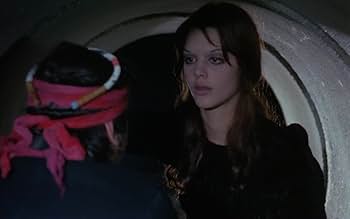What, no user reviews? Let me be first and spare you the pain. The late 60s and early 70s occasioned a lot of comingling of commercial and experimental cinema--all interesting as a sign of the times, some interesting (even great) as art, some...pretty close to unwatchable.
This falls in the latter camp. It features a multinational cast reciting endless tedious theatrical monologues or improvising endless tedious dialogues (each in their own languages, principally Italian, French and English), sure what whatever passes their lips must be avant- garde gold. Well, take enough drugs and you'd think so, too. Some play archetypes like the Frankenstein monster (spaghetti western regular Bruno Corazzari) or Attila the Hun (Pierre Clementi naked on a horse-- one of many things here that sounds more fun that it is).
Hatchet-voiced Viva is reunited with Louis Waldon, with whom she'd made cinematic history the prior year by being the first non-anonymous people to have actual on screen sex in Warhol's "Blue Movie." Sitting on a couch, she natters on about her worthless husband and having never met a "real" man and otherwise goes on as if in some potty-mouthed version of "The Lockhorns." If you find her funny in general, you'll find her funny here.
Paul Jabara (who'd just appeared on Broadway in "Hair" and would later become a disco-era recording star) gets his own monologue involving a very large penis (not his), then stands next to a very large penis (a soft sculpture), on the other side of which he's in drag (thanks to the miracle of double-exposure) impersonating Viva.
Tina Aumont and Carmelo Bene, amongst other hipsters of the time, are also in here. "Necropolis'" attempted outrages against propriety and cinematic convention seldom feel like more than one long druggy bender for all involved, and no, you're never as compelling as you think you are when in an altered state. It's like a static off-off-off-Broadway theater piece of the time, its little skits all shot on barely-dressed interior sets with occasional lurid lighting--not exactly an exciting use of this medium's possibilities.
No doubt it freaked out a dozen or so heavily stoned viewers at the time, out of the couple hundred people likely to have seen it in cinemas, tops. The others were surely bored out of their minds. If you're a completist about such relics from the psychedelic/New Hollywood/counterculture/High Eurosploitation era, you'll be glad to have seen it--though you probably won't enjoy it. If not, be glad it's very hard to see these days (and probably has been for 40-plus years). Really, you're not missing anything but a fine example of the worst kind of self-indulgences this wide-open period encouraged, as it also did so many great, adventurous movies that are better-remembered for obvious reasons.

























